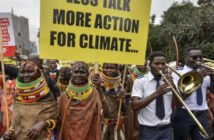Its election day in Kenya. The number of candidates contesting in these elections is the highest ever witnessed in the nation’s history. A total of 14,552 candidates seek to fill 1,882 elective posts. A considerable number of these candidates are running as independents after they were eliminated during the party primaries. This election is the 12th and 11th since independence, and the second under the new Constitution, which was passed in 2010.
The biggest battle is between Raila Odinga and the incumbent President Uhuru Kenyatta. The two have spent considerable sum of money to woo voters. This estimated that both candidates have each spent more than Sh5 billion ($50m) in their campaigns. Helicopters are also freely used by two during the campaigns. Raila Odinga, 73, is contesting for Kenya’s presidency for the fourth time, having run for the presidency three times before – in 1997, 2007, and 2013.
19,611,423 registered voters are eligible to vote in the elections according Kenya’s electoral body, the Independent Electoral and Boundaries Commission (IEBC) register that was updated in June after the KPMG audit.
The winner of Kenya’s presidential race must get more than 50 percent of the votes as well as one-quarter or more votes in at least 24 of Kenya’s 47 counties. If the front-runner falls short of those benchmarks, the two top contenders will contest a runoff vote. President Uhuru Kenyatta and challenger Raila Odinga also faced off in the 2013 election. Kenyatta won by a thin margin, with just over 50 percent of the vote; Odinga alleged vote-tampering and took his case to Kenya’s highest court, which ruled in Kenyatta’s favor by validating the results
The election is the most costly in Kenya’s history and among the most expensive in Africa. Many are, however, sceptical about whether the high costs will translate to benefits despite numerous assurances from the IEBC. In 2013, the biometric voter registration was an embarrassing failure, leading to a loss of around Sh9.95 billion ($95 million) of taxpayers’ money, which was the cost of acquiring the technology.  The election has gobbled up more than Sh49.9 billion, most of which has been used to acquire the KIEMS technology and election materials and hire and train personnel. This is indeed worrying considering that the public debt has risen sharply to 53 per cent of the country’s GDP. The campaigns have also seen a fair share of money at play, with politicians using millions to woo voters.
The election has gobbled up more than Sh49.9 billion, most of which has been used to acquire the KIEMS technology and election materials and hire and train personnel. This is indeed worrying considering that the public debt has risen sharply to 53 per cent of the country’s GDP. The campaigns have also seen a fair share of money at play, with politicians using millions to woo voters.
The elections international observers in Kenya include former U.S. Secretary of State John Kerry and John Mahama, chief election observer for the Commonwealth and former president of Ghana.




